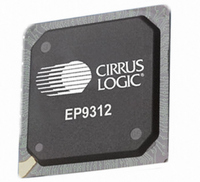EP9312-IB Cirrus Logic Inc, EP9312-IB Datasheet - Page 324

EP9312-IB
Manufacturer Part Number
EP9312-IB
Description
IC ARM920T MCU 200MHZ 352-PBGA
Manufacturer
Cirrus Logic Inc
Series
EP9r
Datasheets
1.EP9307-CRZ.pdf
(824 pages)
2.EP9312-IBZ.pdf
(4 pages)
3.EP9312-CB.pdf
(62 pages)
4.EP9312-CB.pdf
(17 pages)
Specifications of EP9312-IB
Core Processor
ARM9
Core Size
16/32-Bit
Speed
200MHz
Connectivity
EBI/EMI, EIDE, Ethernet, I²C, IrDA, Keypad/Touchscreen, SPI, UART/USART, USB
Peripherals
AC'97, DMA, I²:S, LCD, LED, MaverickKey, POR, PWM, WDT
Number Of I /o
16
Program Memory Type
ROMless
Ram Size
32K x 8
Voltage - Supply (vcc/vdd)
1.65 V ~ 3.6 V
Data Converters
A/D 8x12b
Oscillator Type
External
Operating Temperature
-40°C ~ 85°C
Package / Case
352-BGA
Processor Series
EP93xx
Core
ARM920T
Data Bus Width
32 bit
3rd Party Development Tools
MDK-ARM, RL-ARM, ULINK2
Lead Free Status / RoHS Status
Contains lead / RoHS non-compliant
Eeprom Size
-
Program Memory Size
-
Lead Free Status / Rohs Status
No
Other names
598-1259
Available stocks
Company
Part Number
Manufacturer
Quantity
Price
Company:
Part Number:
EP9312-IBZ
Manufacturer:
CIRRUS
Quantity:
30
Company:
Part Number:
EP9312-IBZ
Manufacturer:
HITTITE
Quantity:
1 200
- EP9307-CRZ PDF datasheet
- EP9312-IBZ PDF datasheet #2
- EP9312-CB PDF datasheet #3
- EP9312-CB PDF datasheet #4
- Current page: 324 of 824
- Download datasheet (13Mb)
9
9-22
1/10/100 Mbps Ethernet LAN Controller
EP93xx User’s Guide
9.2.3.3 Receive Errors
Refer to the circled numbers in
Receive error conditions are broken into two categories: hard errors and soft errors. A hard
error is generally considered a reliability problem. This includes AHB bus access problems. A
soft error indicates that the frame was not successfully received. The error may be expected
or rare. A soft error needs a graceful recovery by the host driver. Soft errors include: CRC
errors, receiver over-run, frames too long, or frames too short. Hard errors are parity errors
(when enabled), system errors, and master or target aborts, these errors will stop receive
DMA activity, and require host intervention for recovery. Recovery may be achieved by
performing a RxChRes (Bus Master Control) and reinitializing.
Note:
Note: Steps 1, 11, and 13 are transparent to the MAC. Steps 2 through 10 and 12 directly involve
1. Driver initializes some number of receive descriptors.
2. Driver writes RXDEnq register with the additional number of receive descriptors.
3. On-chip Descriptor Processor fetches descriptors into internal FIFO decrements
4. The address of the next receive data buffer is loaded into the Receive Buffer Current
5. A frame is received from the LAN medium.
6. The MAC Engine passes the frame data to the Receive Data FIFO.
7. The Receive Descriptor Processor stores the frame data into system memory.
8. End of frame status is written to the Receive Status Queue the RXStsEnq value reduced
9. Driver interrupted if interrupt conditions met.
10.Received frame passed to the protocol stack.
11.Driver clears the Receive Frame Processed bit in Status Queue.
12.Driver writes number of entries processed in the status queue, freeing them for future
13.After the driver gets the used receive buffers back from the stack, the driver may repeat
RXDEnq appropriately.
Address.
by one.
use by the MAC.
step 2.
the MAC.
Steps 5, 6, and 7 can overlap.
Copyright 2007 Cirrus Logic
Figure
9-9. The detailed receive flow is:
DS785UM1
Related parts for EP9312-IB
Image
Part Number
Description
Manufacturer
Datasheet
Request
R

Part Number:
Description:
IC ARM920T MCU 200MHZ 352-PBGA
Manufacturer:
Cirrus Logic Inc
Datasheet:

Part Number:
Description:
IC ARM9 SOC UNIVERSAL 352PBGA
Manufacturer:
Cirrus Logic Inc
Datasheet:

Part Number:
Description:
System-on-Chip Processor
Manufacturer:
Cirrus Logic Inc
Datasheet:

Part Number:
Description:
IC ARM920T MCU 200MHZ 352-PBGA
Manufacturer:
Cirrus Logic Inc
Datasheet:

Part Number:
Description:
IC ARM920T MCU 200MHZ 352-PBGA
Manufacturer:
Cirrus Logic Inc
Datasheet:

Part Number:
Description:
IC ARM920T MCU 166MHZ 208-LQFP
Manufacturer:
Cirrus Logic Inc
Datasheet:

Part Number:
Description:
IC ARM920T MCU 166MHZ 208-LQFP
Manufacturer:
Cirrus Logic Inc
Datasheet:

Part Number:
Description:
Development Kit
Manufacturer:
Cirrus Logic Inc
Datasheet:

Part Number:
Description:
Development Kit
Manufacturer:
Cirrus Logic Inc
Datasheet:

Part Number:
Description:
High-efficiency PFC + Fluorescent Lamp Driver Reference Design
Manufacturer:
Cirrus Logic Inc
Datasheet:

Part Number:
Description:
Development Kit
Manufacturer:
Cirrus Logic Inc
Datasheet:

Part Number:
Description:
Development Kit
Manufacturer:
Cirrus Logic Inc
Datasheet:

Part Number:
Description:
Ref Bd For Speakerbar MSA & DSP Products
Manufacturer:
Cirrus Logic Inc












